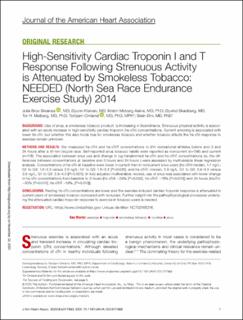| dc.contributor.author | Skranes, Julia Brox | |
| dc.contributor.author | Kleiven, Øyunn | |
| dc.contributor.author | Aakre, Kristin Moberg | |
| dc.contributor.author | Skadberg, Øyvind | |
| dc.contributor.author | Melberg, Tor Harald | |
| dc.contributor.author | Omland, Torbjørn | |
| dc.contributor.author | Ørn, Stein | |
| dc.date.accessioned | 2023-02-14T10:17:18Z | |
| dc.date.available | 2023-02-14T10:17:18Z | |
| dc.date.created | 2020-11-19T15:22:52Z | |
| dc.date.issued | 2020 | |
| dc.identifier.citation | Skranes, J. B., Kleiven, Ø., Aakre, K. M., Skadberg, Ø., Melberg, T. H., Omland, T., & Ørn, S. (2020). High‐Sensitivity Cardiac Troponin I and T Response Following Strenuous Activity is Attenuated by Smokeless Tobacco: NEEDED (North Sea Race Endurance Exercise Study) 2014. Journal of the American Heart Association, 9(19), e017363. | en_US |
| dc.identifier.issn | 2047-9980 | |
| dc.identifier.uri | https://hdl.handle.net/11250/3050625 | |
| dc.description.abstract | Background
Use of snus, a smokeless tobacco product, is increasing in Scandinavia. Strenuous physical activity is associated with an acute increase in high‐sensitivity cardiac troponin (swhs‐cTn) concentrations. Current smoking is associated with lower hs‐cTn, but whether this also holds true for smokeless tobacco and whether tobacco affects the hs‐cTn response to exercise remain unknown.
Methods and Results
We measured hs‐cTnI and hs‐cTnT concentrations in 914 recreational athletes before and 3 and 24 hours after a 91‐km bicycle race. Self‐reported snus tobacco habits were reported as noncurrent (n=796) and current (n=118). The association between snus use and change in log‐transformed hs‐cTnI and hs‐cTnT concentrations (ie, the differences between concentrations at baseline and 3 hours and 24 hours ) were assessed by multivariable linear regression analysis. Concentrations of hs‐cTn at baseline were lower in current than in noncurrent snus users (hs‐cTnI median, 1.7 ng/L; Q1 to Q3: 1.6–2.3 versus 2.0 ng/L; Q1 to Q3: 1.6–3.2 [P=0.020]; and hs‐cTnT: median, 2.9 ng/L, Q1 to Q3: 2.9–3.5 versus 2.9 ng/L, Q1 to Q3: 2.9–4.3 [P=0.021]). In fully adjusted multivariable models, use of snus was associated with lower change in hs‐cTn concentrations from baseline to 3 hours (hs‐cTnI: −29% [P=0.002], hs‐cTnT: −18% [P=0.010]) and 24 hours (hscTnI: −30% [P=0.010], hs‐cTnT −19%, [P=0.013]).
Conclusions
Resting hs‐cTn concentrations are lower and the exercise‐induced cardiac troponin response is attenuated in current users of smokeless tobacco compared with nonusers. Further insight into the pathophysiological processes underlying the attenuated cardiac troponin response to exercise in tobacco users is needed. | en_US |
| dc.language.iso | eng | en_US |
| dc.publisher | American Heart Association | en_US |
| dc.rights | Navngivelse 4.0 Internasjonal | * |
| dc.rights.uri | http://creativecommons.org/licenses/by/4.0/deed.no | * |
| dc.title | High-Sensitivity Cardiac Troponin I and T Response Following Strenuous Activity is Attenuated by Smokeless Tobacco: NEEDED (North Sea Race Endurance Exercise Study) 2014 | en_US |
| dc.type | Peer reviewed | en_US |
| dc.type | Journal article | en_US |
| dc.description.version | publishedVersion | en_US |
| dc.rights.holder | The authors | en_US |
| dc.subject.nsi | VDP::Medisinske Fag: 700 | en_US |
| dc.source.pagenumber | 14 | en_US |
| dc.source.volume | 9 | en_US |
| dc.source.journal | Journal of the American Heart Association | en_US |
| dc.identifier.doi | 10.1161/JAHA.120.017363 | |
| dc.identifier.cristin | 1850019 | |
| cristin.ispublished | true | |
| cristin.fulltext | original | |
| cristin.qualitycode | 1 | |

